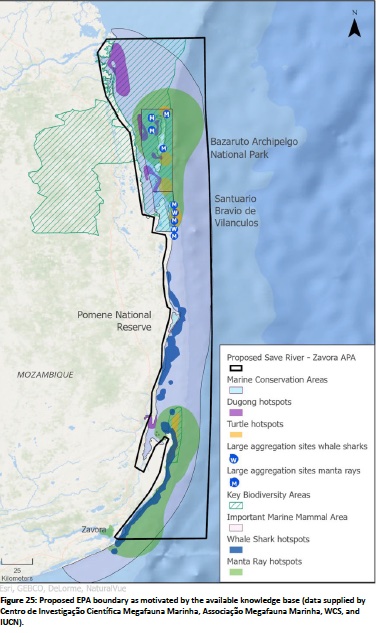
18 March 2021. The Task Force welcomes a new report from Conservation International (CI) detailing a stakeholder workshop in November 2020 convened in southern Mozambique on behalf of the National Administration of Conservation Areas (ANAC), to make a new Environmental Protection Area (EPA)[1] along the coast of Inhambane Province.
Working with local communities, the CI workshop forged a preliminary vision for the proposed EPA, presented biological evidence for the creation of the proposed EPA citing surveys and study results, and developed a planning process to define the next steps for implementation.
The proposed EPA site corresponds to the 16,280 km2 Bazaruto Archipelago to Inhambane Bay IMMA[2] which was identified at the Western Indian Ocean and Arabian Seas IMMA Workshop and, in November 2019, became the subject of stakeholder and government meetings conducted on location by Task Force co-chairs Giuseppe Notarbartolo di Sciara and Erich Hoyt.
The site features dugongs, Indian Ocean humpback dolphins, humpback whales, various sharks and rays, marine turtles, and marine birds. These habitats are recognized not only by the IMMA but by smaller portions of habitat identified as Key Biodiversity Areas (KBAs) and Important Bird and Biodiversity Areas (IBAs).
Following presentations on the key species, tourism and community activities, and the ecosystem threats including unsustainable fishing, mining concessions, coastal development and climate change, the group agreed on a way forward. Management recommendations include:
- Nominate the “Bazaruto Archipelago to Inhambane Bay IMMA” as a World Heritage Site, using the outstanding universal value of the dugongs and their seagrass habitat as a strong case for justification;
- Create specific Areas of Protection within the EPA (through zoning) or additional Conservation Areas (CAs) to strengthen the management of key species and habitats that are important to biodiversity, to people, and that adds value to the region’s blue economy;
- Reduce and eliminate anthropogenic pressures in the IMMA, including bycatch in gillnets, oil and gas development, mining, and disturbance from unregulated tourism;
- Select low-density tourism and conservation activities as the preferred land-use in this area to create jobs and sustainable revenues with maximum impact, and which would enhance conservation and protection measures;
- Promote scientific research to inform decision-making processes, improve park management and design monitoring programs;
- Encourage local community involvement and alternative livelihood projects to enhance economic development, such as building a sustainable tourism industry around marine megafauna encounters, and introduce Community Behaviour Adoption approaches.
For more information and a copy of the report, contact Karen Allen <consultant17@conservation.org>.
[1] An EPA is described as a “sustainable use conservation area in the public domain of the State, delimited, managed in an integrated manner, where the interaction between human activity and nature endows the landscape with specific and exceptional aesthetic, ecological or cultural qualities, offering important ecological services for its residents and neighbours.”
[2] An Important Marine Mammal Area, or IMMA, is defined by the International Union for Conservation of Nature (IUCN), the Species Survival Commission (SSC), and the World Commission on Protected Areas (WCPA) as a discrete portion of habitat, important for one or more marine mammal species, which have the potential to be delineated and managed for conservation.

 © N. Shumeyko 2019
© N. Shumeyko 2019